
Throughout the years, much has been made about the intensity and competitiveness of sports at the highest level. In professional basketball, it’s about the hours dedicated to running sprints, taking thousands of jump shots, training your legs to jump quickly a second time after a hotly contested rebound. None of these things are glamorous.
They’re all done behind the scenes, when no one is watching, so that a player can get an edge. It could be an advantage on another player trying out for the team, someone who is vying for the same minutes in the rotation, or to outlast an opponent when crunch time arrives in the fourth quarter. The greatest of all time usually take it one step further and compete with themselves, to raise their standard of excellence to an even higher level.
NBA fans certainly appreciate players who leave it all on the line, and try to get it done no matter how ugly it can look. But there are others who see beyond the competitive landscape, and internalize NBA basketball for what is truly is for a lot of people; entertainment, or a two and a half hour distraction from daily life. It can be risky to think that way if ample work is not put in, but when hard work meets flair, the results can be illustrious.
Enter Pistol Pete Maravich, who viewed the game very differently than a lot of his contemporaries. Most of the other players in his era solely wanted to win, and lead their teams deep into the playoffs to compete for an NBA title. Those accomplishments have traditionally been what separate the great players from those with unimpeachable resumes. But Pistol Pete (hence the nickname) understood that a certain style of play could invigorate a fan base, and a league that needed to brand itself more widely than it currently had.
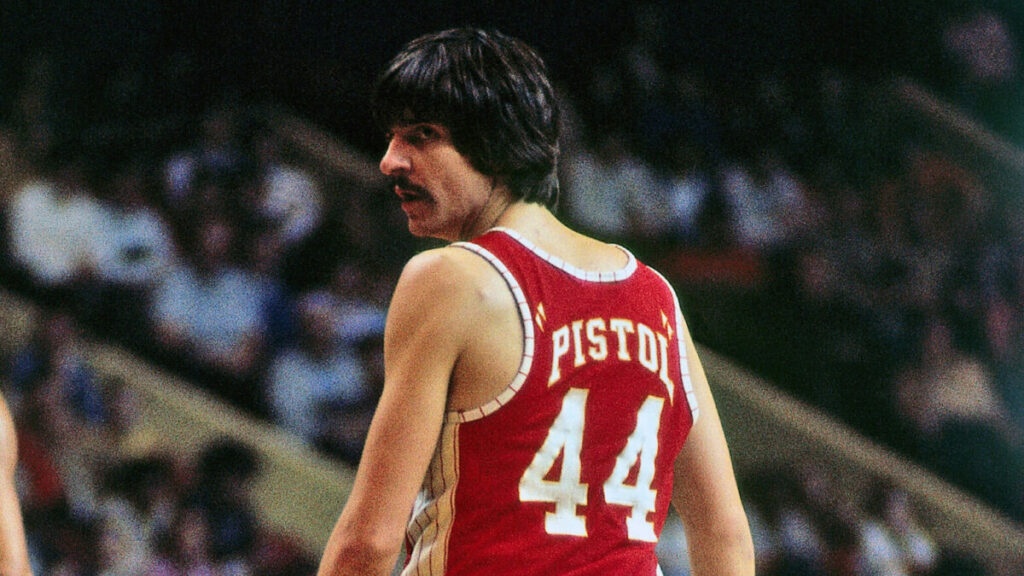
Having the crowd leap up from their seats to yell about something they had never seen before, or putting a little extra pizzazz on a pass because the teammate was wide open anyway would only help the game. Winning the game would be a cherry on top of all the above.
Pete Maravich understood that there was a chance someone in the stands or on television would only get a chance to watch him one time, and he wanted to make that experience a memorable one. Perhaps more than any other player in NBA history, Maravich realized that he was the conductor in an athletic show.
Pete Maravich – Childhood
Peter Press Maravich’s unique story began in Aliquippa, Pennsylvania on June 22, 1947. He was born to parents Helen Maravich and Press Maravich. Before anyone can understand the mannerisms and upbringing of Pete, the background of Press needs to be examined.
The family was of Serbian descent, and Press’ own father worked very hard in less than glamorous jobs to help his kin achieve the “American Dream.” Vajo Maravich made a life for his children in western Pennsylvania as well, which was(and still largely is) a blue collar area. It is right outside of Pittsburgh, which is well known for its steel manufacturing production. Vajo Maravich worked in a huge steel plant owned by Jones and Laughlin, since that is what a lot of his neighbors did to earn a living.
However, Press Maravich had different interests and goals than his father. He fell in love with basketball, which at that time was predominantly played just in the United States. Press would work on his game as a kid, even without a popular professional league to aspire to.

Without much of a blueprint to follow, Press followed his passion, which opened up a few doors for him. He was able to attend Davis and Elkins College in West Virginia, and play in some of the first basketball leagues in the 1940’s. He would end up serving in World War II for the United States, but would end up playing basketball again upon his return. Not sports reference llc, but basketball reference llc has recorded statistics of Press Maravich playing in 51 games for the Pittsburgh Ironmen of the Basketball Association of America in 1946-1947.
Of course, later that summer, his son Pete would come into the world. Around that time, Press came to grips with the idea that he was not going to be able to continue playing professional basketball. However, he would do everything in his power to ensure that Pete would have a legitimate chance at becoming a basketball prodigy.
There have been other stories of fathers super imposing their dreams on their sons, only for it to have negative results. One could argue that Pete Maravich’s tale was one of the more successful iterations of this storyline, since we know that he achieved great things in the NBA. Press would have his son work on his basketball skills even when he was on his way to doing something else. Pete would be seen bouncing a ball on his way to the movies, or even while he was riding a bicycle. The boy would also spend time in his proverbial lab perfecting trick shots, head fakes, and behind the back passes.
Because of the four to five hours of work he would put in each day, and his advanced control of the basketball, young Pete Maravich would become something of a traveling circus. There were stories of him dribbling blindfolded around the store while adults cheered and marveled at the fact that he did not lose the basketball.
Allegedly, Maravich also used his supreme skill to make a few extra dollars on the side. He accepted a bet from a neighborhood kid that he could successfully spin a ball on his finger for an entire hour. As the minutes passed, his arm started to get tired, and finger started to bleed. The kid who made the wager thought that he would not have to pay up since it looked like Maravich was going to give up. Instead, he passed the ball from one finger to another on the opposite hand, and successfully completed the bet.
It is stories like these which add fuel to the fire of the basketball legend.
Pete Maravich – High School
For most regular children growing up in the United States, high school begins around age 13 or 14. However, it was apparent that Pete Maravich was different from most of his counterparts. His level of proficiency with a basketball was so advanced that people wanted to see him square off against more developed competition earlier in life.
Press Maravich’s coaching career had taken off, and his first opportunity came leading Clemson University’s basketball program. As a result, his family moved to South Carolina, which is where Pete began his high school career…before he was actually in high school. He would get his first taste of the next level as an eighth grader playing for Daniel High School. While it would not take long for Maravich’s skills to manifest, his biggest challenge would be holding up against players several years older. In the first few games, they played a physical style of defense against the ballhandling whiz, which Maravich was not quite ready to handle at 5’2” and 90 pounds. The diminutive but intellectually sharp guard would figure out how to adjust to this, by selling contact and falling on the floor when a sturdy arm was positioned against his chest.
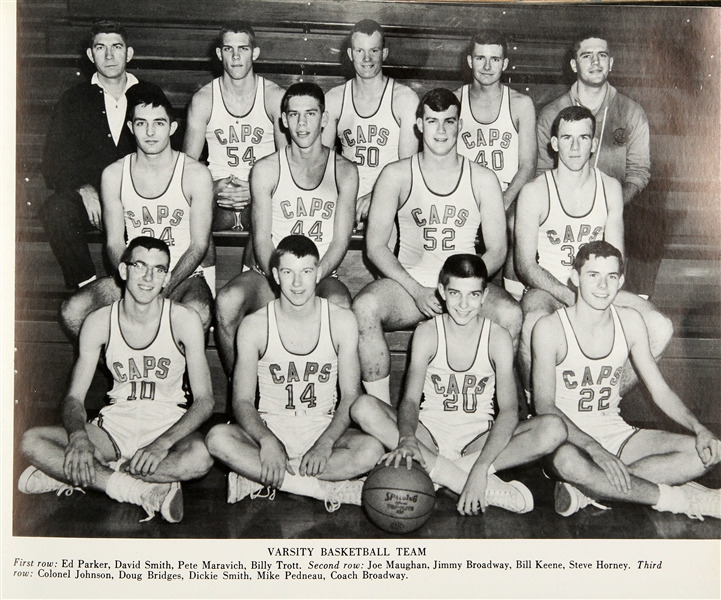
Before long, the kid who was not supposed to be playing with the more developed teenagers was running circles around them. He averaged 33 points per game, essentially just testing out high school basketball before his time truly arrived.
Maravich would spend a couple of years playing at Daniel High School in South Carolina before his father’s coaching career would necessitate another family move. After six seasons coaching at Clemson and a couple years to ponder what he would do next, Press accepted the head coaching job at North Carolina State. As a result, the Maravich clan would move up north, and Pete would play at a new high school.
That new team would be for the Capitals of Needham Broughton High School in Raleigh, North Carolina. Quite predictably, Maravich’s geographical relocation had no discernable impact on his performance on the court. He would put up 32 points per game for his new school, and would be widely recognized for his magnificent floor game throughout the state.
As if two high school fan bases weren’t lucky enough to see Pete Maravich play, a third institution would be treated to legendary performances for a year. He spent the 1965-1966 school year at Edwards Military Institute to round out his brilliant high school career.
Pete Maravich – College
On paper, and on any type of grainy black and white highlight films available in the 1960’s, Pete Maravich’s basketball next steps should have been abundantly clear. He appeared destined to play with any blue blood program of his choosing, and win multiple NCAA Tournament championships in the process. Legendary UCLA head coach John Wooden would later call Maravich the greatest dribbler he had ever seen, so it would make sense for the Pennsylvania native to take his talents to the west coast where he could pass to future Naismith Memorial Basketball Hall of Fame teammates.
There were a couple of issues with that inevitably destiny though. For one thing, Maravich’s grades were not all that great in high school. It was said that he was so singularly focused on basketball, and tricks he could perform with it, that his academic responsibilities often were not considered a priority. It would have made sense for Maravich to go to college in or near the Carolinas, but his scoring would not allow for it. The ACC(Atlantic Coast Conference) had a minimum SAT score requirement that Maravich did not meet, which ruled out universities like N.C. State, North Carolina, Duke and Virginia.
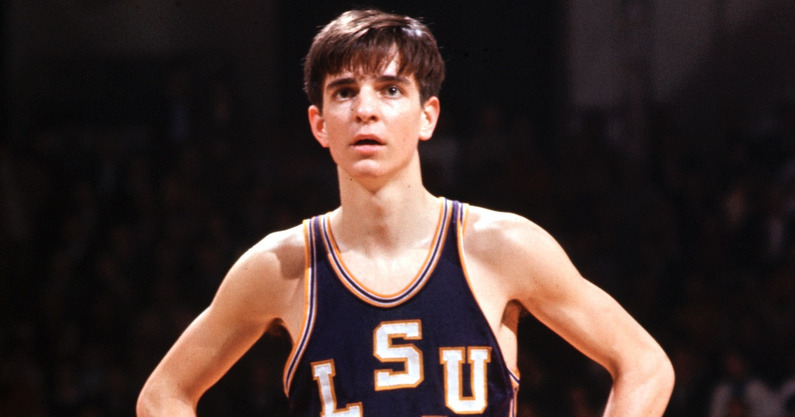
As a result, the basketball phenomenon was left somewhat in limbo. He would end up playing for Southwood College while his ultimate college basketball future was decided. This would not affect his eventual NCAA eligibility however, because despite its name, Southwood was a prep school, and not an actual college. Even still, they had a basketball program, and would give Maravich exposure to some of the larger school college basketball players he would eventually face. Southwood would have the opportunity to play against the Duke freshman team, for example.
But everyone knew that Maravich’s pit stop there was only a means to a much larger end. At this critical time in Pete’s basketball timeline, a familiar face would factor into what would happen next; his father Press.
Press Maravich had done a tremendous job reviving the North Carolina State Wolfpack team, leading them to a 38-13 overall record in his two years there. Press had much more success there than in any of his six seasons coaching the Clemson Tigers. It was a bit of a surprise that he would consider going anywhere else since the foundation of N.C. State was strong, but Press’ next career move was directly related to what Pete would do next.
In a rare but intriguing package deal, both Maravich’s would head to Louisiana State University in 1966. Press would immediately be installed as head coach, but would not get to coach his son for the first season. In those days, college basketball freshmen played on their own specific freshman team, and would move up to the varsity once they were sophomores. Press’ 1966-1967 team had an abysmal year, going 3-23 in the regular season. This was not necessarily a surprise however, as the program had been struggling to find its footing.
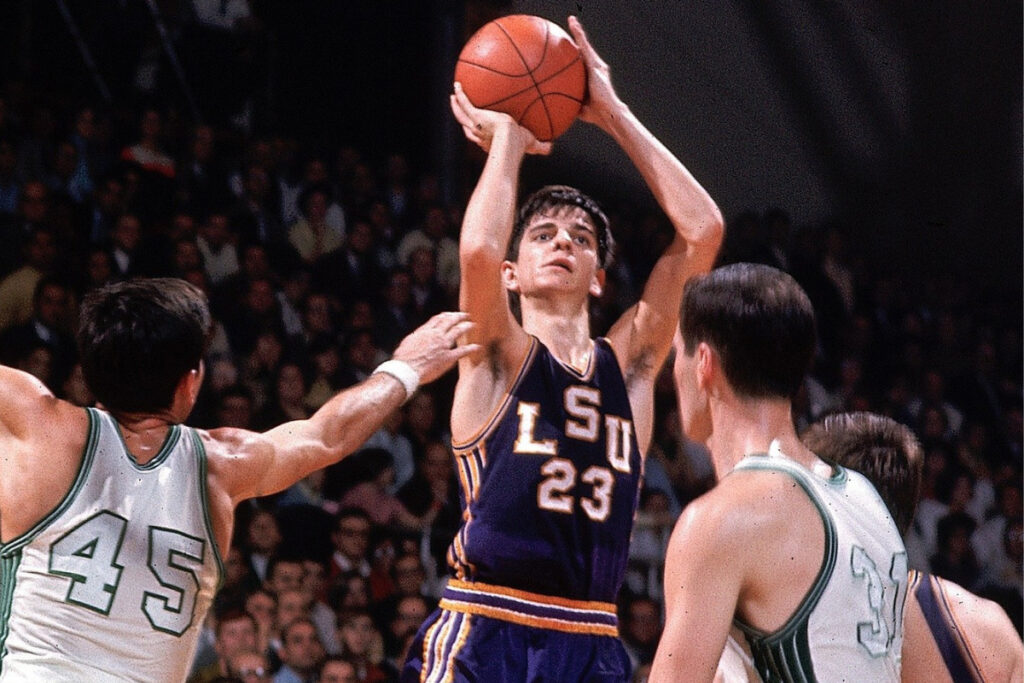
Meanwhile for the LSU freshman team Pete Maravich was putting on a show. It was not uncommon for Tigers fans to watch the freshman team’s game to soak in the fantastic freshman’s performances, and then leave when the varsity team would practice or play. From day one, Maravich impressed, posting a triple double in his first game on the lower ranks while scoring 50 points. He would average a mind boggling 43 points per game on that level.
An extremely long year for LSU fans finally would come to an end, which meant that the team would have a Maravich on the court and a Maravich on the adjacent bench for the 1967-1968 season. Predictably, the team’s fortunes would improve with their star recruit on the floor, as they would finish with at least a .500 record in each of Maravich’s three college seasons with the varsity team. Although they were not a national powerhouse that threatened some of the blue bloods for championship glory, the LSU Tigers were one of the most fun teams to watch in the country.
Maravich’s scoring and passing prowess were jaw dropping. He averaged over 44 points per game at LSU combined, which is the highest in NCAA history. With all of the defensive attention focused on him, and without otherworldly athleticism, Maravich still found ways to get his shot off with creative release points and unorthodox attempts. It’s also fascinating to remember that he put up these unprecedented numbers without two distinct advantages that help scoring statistics.
First of all, there was no shot clock in college basketball until the 1985-1986 season. This meant that in theory, an offensive team could wait as long as they wanted before putting up a shot. Certain teams played an ultra-conservative approach, taking advantage of this rule to minimize the total possessions in the basketball game. When teams faced off against LSU, it was very likely that opposing coaches tried to use this in order to minimize Maravich’s impact. Despite that, he was able to hoist an average of 38 shots per game, or nearly one for each minute of a college game.
Secondly, the three point line had not yet been introduced to the college or NBA game. By all accounts, Maravich had the kind of range that modern day NBA fans are used to seeing with the likes of Stephen Curry or Damian Lillard. Of course, those long range shots count for three points in today’s game, but when Maravich was connecting from that distance, they were worth the same two points as a regular layup. Because of that, there were many basketball traditionalists who did not like the way Maravich played, because he was taking more difficult shots for the exact same reward as a closer attempt.
“Pistol” Pete Maravich weaves through defenders for the layup (12/30/1973)#NBAHandlesWeek pic.twitter.com/owLzWEBmBA
— NBA UK (@NBAUK) August 9, 2022
Regardless of how he got there, Maravich authored one of the most decorated college careers in basketball history. He is the all-time leading scorer in college basketball history, and was a unanimous first-team All-American in each of his three varsity seasons. The Sporting News College Player Of The Year award was also given to Pete Maravich in 1970. The accolades from his days at LSU truly can go on forever.
Pete Maravich – Atlanta Hawks
As exciting as it was for Pete and Press Maravich to take the college basketball world by storm with LSU, there were bigger dreams to realize. Pete was on the precipice of playing professional basketball, which is the vision that Press had for his son since he was born. It would only be a matter of time before it became a reality.
Coming out of college in the late 1960’s and early 1970’s meant that basketball players would have a choice as to what league they would play professionally in. The ABA was an upstart league that was an interesting alternative for a player like Maravich. That league did have a three point line, and generally played at a faster pace than its counterparts. The NBA was the gold standard of basketball though, and Maravich’s image, accomplishments and game would be featured more prominently in the media there.
Not surprisingly, the ABA made a run at Maravich. The Carolina Cougars selected Pete Maravich in the 1970 ABA Draft. The Atlanta Hawks of the NBA would also selected Maravich in their draft in the same year; Atlanta took him third overall. As a result, Maravich had bargaining power as the two teams vied for his services. In the end, it was Atlanta who offered the former LSU star a then record setting contract of $1.9 million to play there, which Maravich accepted.

The Hawks needed a player that the city would gravitate towards to help sell tickets, and ideally, win games. The team has only been in Atlanta for two years before they drafted Pete Maravich, and were still looking to establish a fanbase in the city. Atlanta was also bringing other professional teams in as well, so the Hawks needed to remain relevant as it related to other sports as well.
Atlanta already a talented scorer on the roster in Lou Hudson, and other talent such as center Walt Bellamy. It was going to be interesting to see how the ball dominant Maravich would fit in with those established veterans. He was still able to get his numbers, as he averaged over 23 points per game in his rookie year. In his next two years with the Hawks, he would average over six assists per game, seeming to understand that moving the ball would be the best chance for team success.
The Hawks would end up making the playoffs in each of Pistol Pete’s first three seasons in the NBA, but bowed out of the postseason in the Eastern Conference Semifinals each year. In 1973-1974, the franchise and the players on the team were very motivated to get better results. Pete Maravich would take matters into his own hands, by averaging a career high in shot attempts and points scored in his fourth season with Atlanta.
However, they ended up winning fewer games that season, and there was reported tension in the locker room. There was a prevailing narrative that despite Maravich’s acceptable offensive statistics, he was the main reason for the team’s lack of success. Critics said that his lack of defensive ability or intensity would too frequently put Atlanta in positions that they could not recover from.
While it is not clear whether Pistol Pete heard this chatter, he too was frustrated. According to reports, head coach Cotton Fitzsimmons would reveal that Maravich did not respond to a word he said during the second half of the season. The team would also suspend Maravich for three days in the middle of the year.
While no one questioned the amount of talent he brought to the table, it was apparent in 1974 that the partnership between Atlanta and its former prized draft back had fallen apart, and something needed to change.
Pete Maravich – New Orleans Jazz
Even though Maravich and the Hawks’ front office tried to clear the air, the damage was done. Atlanta was on the phone trying to shop Pistol Pete around the league, and interestingly did not have as much interest as they would’ve expected for a two-time All-Star.
Something would eventually get done though, and it would be finalized in Maravich’s own home. Hawks general manager Pat Williams brought the president and general manager of the expansion New Orleans franchise to his apartment, so the player could get familiar with his new bosses. Maravich came away impressive with them, and loved that they thought so highly of him.
Here’s Pistol Pete Maravich demonstrating some of his favorite ball handling drills to an impressed Red Auerbach.
— Super 70s Sports (@Super70sSports) August 16, 2022
pic.twitter.com/BWWbqcVFbH
In this day and age, NBA fans are used to convoluted trades that involve multiple players and several first round draft picks. The Maravich trade to New Orleans resembled something that a current fan might be used to, since the two teams had the option of swapping picks in future NBA Drafts.
It made a lot of sense for both sides. Maravich would have a chance to get away from the pressure-packed situation he started to loathe in Atlanta, and into an expectation-free setting in New Orleans. The franchise would eventually settle on the Jazz nickname, and Maravich’s style of play was reminiscent of that style of music. Of course, he also spent his college years starring in Baton Rouge, Louisiana, so there was a fit there as well.
Although the Jazz would never make the playoffs in Maravich’s time there, he would electrify home crowds and re-establish his credibility as one of the NBA’s most talented players. In his last three seasons in New Orleans, he would return to the NBA All-Star Game. Perhaps his most memorable game came against the New York Knicks in February of 1977, where he dropped 68 points in a home game. It was eerily similar to the type of things he used to back when he was an LSU Tigers player.
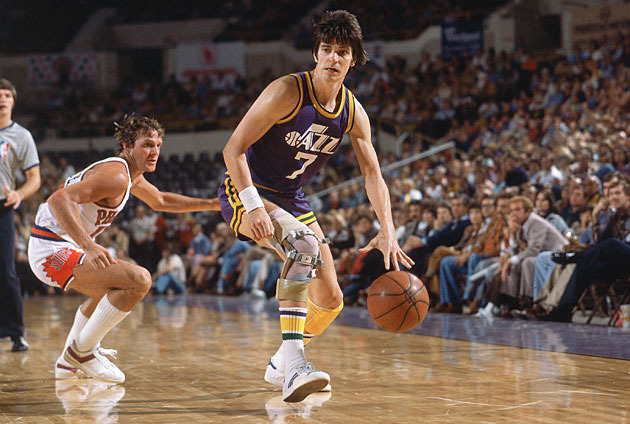
Even though he was still a must-see player, Maravich started to have some knee problems when he turned 30 years old. Even though he was named to the All-Star team, he would miss over 30 games in each of his final two seasons with New Orleans. It was fun watching him be the center of attention, but it seemed like it was finally starting to take a toll on his body.
Pete Maravich – Utah Jazz
Unfortunately for the city of New Orleans, having Maravich as the primary draw on a losing team was not quite enough to keep the interest level where it needed to be for sustainability. As a result, the team decided to pack their bags and head west to Utah ahead of the 1979-1980 campaign. This would effectively signal a changing of the guard for the franchise, both from a branding perspective and on the floor.
The team hired new coach Tom Nissalke for their inaugural campaign in Salt Lake City, who wanted to move away from Maravich. Pistol Pete came off the bench in the first 17 games he appeared in that year, and it was clear that the Utah Jazz were giving the keys of the franchise to Adrian Dantley, who they traded for in the prior offseason.
Pete Maravich’s time with the Jazz franchise would come to an unceremonious end, as he was waived in January of 1980.
Pete Maravich – Boston Celtics
However, Maravich wasn’t out of the league for very long. Five days later, he was picked up by the Boston Celtics. He would end up joining one of the more fascinating rosters in league history. That season was Larry Bird’s first year in the NBA, and Boston already had veterans like Tiny Archibald and Dave Cowens to handle the perimeter and the post. Maravich’s presence on the roster meant that four NBA greats would intersect at very different points of their careers.
The Celtics would end up making it all the way to the Eastern Conference Finals that year, with Maravich playing a contributing role off of the bench. In his final NBA game, Maravich played 17 minutes, scoring four points with one steal and one rebound.
Pete Maravich – Post NBA Life
During the course of his NBA career, it seems fair to say that Pete Maravich battled his share of personal demons. Some say that the pressure his father put on him, and that Pistol Pete put on himself, to become the most technically proficient basketball played who ever lived ended up damaging his emotional state. He would be known to enjoy parties off the court while in college and during his NBA career as a way to blow off steam.
In order to help get his life back on track, Maravich became focused on the Christian faith, which he felt would help guide him on a more healthy path.
Pistol Pete Maravich…a man truly ahead of his time pic.twitter.com/Z3co9p1A8x
— Only The Ball Was Brown (@inthelowpost) August 9, 2022
It seemed like things were working for Maravich, as he appeared happy with his wife and children. Unfortunately, things came to a tragic and very sudden end for him in 1988. He was in Southern California to help shoot a series of videos about the Christian faith, but could not say no to a pickup game of basketball being held at the local church. In that game, Maravich ended up suffering a heart attack, which he would end up dying from.
Pete Maravich – Net Worth
Pete Maravich was a five-time NBA All-Star who had an estimated net worth of between $1 million and $5 million at the time of his death in 1988. He was one of the highest paid players of his era and was known for his eccentric lifestyle and flamboyant spending habits.
How did Pete Maravich predict his death?
Pete Maravich made what appeared to be an innocuous comment when he was in his mid 20’s, saying that he did not want to play 10 years in the NBA and then die of a heart attack at age 40. What was incredibly eerie about that comment was that it came true in every way. He played exactly 10 years in the NBA, and he did pass away at 40. He died from a heart attack due to an unknown heart defect he had. He was playing basketball when he died, in a Southern California pickup game when he was filming a movie.
Does Pete Maravich have a ring?
In his brilliant NBA career, Pete Maravich was never on a team that won an NBA championship. Fans and teammates had different opinions of this outcome. Certain people were surprised that he was never able to get close to winning a title, because he did love to pass the ball to the open player with a fancy maneuver. Other folks were not surprised about the lack of team success Maravich experienced, because even though he was willing to share the ball, they felt that the game had to be centered around his advanced skills. He did not join a team late in his career as a reserve to chase a ring.
How many points did Pistol Pete average at LSU?
Pete Maravich, or Pistol Pete as he was known, averaged a mind-boggling 44.2 points as a college player. Back in those days, freshman were not allowed to play on the university varsity team, but Maravich’s performances on the lower team were still must see games for LSU fans. He averaged 43 points and 10 rebounds at that level. What makes his scoring prowess even more amazing is that he did all of this without the benefit of a three point line. Maravich would routinely pull up from what he known as three point distance and bury the shot, but would only get two points for it.





